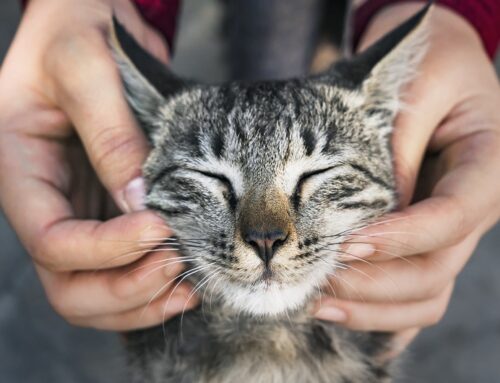June is Adopt-a-Cat Month! Last month we took a look at how feral cats interact so that we can better understand why cats behave the way they do. The important points to remember are:
1.) Even though cats that are raised together can co-exist, they are solitary hunters.
2.) Cats establish their own territories in a given area.
3.) Cats do not have a good way to visually indicate submission to a “dominant” cat. If a new cat wanders into another cat’s territory, the new cat will either run away or fight.
4.) A new cat can integrate into a group, but it takes time and lots of positive interactions.
This means that the resident cat (the one already living in the house) will view any new cat as a threat to their territory; and the new cat will suddenly be in an unfamiliar (and possibly hostile) territory. Stress all around! But, there are steps we can take to make the situation less stressful and encourage the cats to “share” the territory of your home. There is no set timeline for introducing new cats, but it is important to always go slowly and not try to rush things. You will have to go at the pace of the most stressed cat, whether that is the new cat or one of your resident cats. It only takes one bad interaction (likely a fight) to potentially ruin the whole process.
If you are thinking of adopting a new cat, keep in mind how your resident cat behaves. Highly active cats may be overwhelming to less active cats. Sexually intact cats will, in general, be more aggressive in defending their territory. Also, older cats with arthritis or cats with medical problems that are painful may never accept another cat in the household. Always make sure pain is well-controlled and chronic conditions are stable before trying to bring a new cat into the house. In general, most shelters and rescue organizations will do a basic behavior screening on animals in their care and should be able to give you some baseline behavior information on your new cat. Additionally, if you are adopting a barn cat/kitten, remember that there are some cats that will never tolerate human contact; feral cats/kittens should remain feral.
Before you bring your new feline family member home, it is best to already have a small, safe territory set up where he/she can immediately go. At the same time, make sure you have the time to help your new kitty acclimate to the new surroundings. The room should have a door that can close off from the rest of the house. In the safe room, there should be a litterbox, food and water, toys, a scratching post or kitty condo, a window, and lots of hiding areas such as closed cardboard boxes with holes cut in the side. If there are high shelving, bookcases or furniture in the room, make sure all breakables are removed, as many cats like to climb as high as possible (as this lets them survey the area while feeling protected.)
Once you are home, let the kitty come out of the travel carrier at his/her own pace. Let them explore the room on their own, but stay with them to give encouragement through treats and toys. Toys should be kept away from hands; use longer stick toys with feathers or jangles at the end so no accidental scratches occur. Do not pet the cat unless it comes over to you and asks for petting, as the cat will be stressed and possibly over-stimulated. Unwanted attention could lead to scratching or biting. There is nothing special to do with the resident cat(s) at this time. They will be able to smell the newcomer through the door.
So, after the cat is set up in it’s own territory, when do we begin introductions? Well, introductions have already begun! Remember, they can smell (and probably hear) each other through the door. The next step is to make sure any interactions between the cats are positive – food and toys will be your best allies!
First, we will look at the food aspect. All cats should be fed at the same time on either side of the door. Always start food bowls at a distance from the door that all cats feel comfortable. For example, if there is a cat that won’t come within six feet of the door, then don’t place the food bowl closer than that distance. Start where all cats are comfortable and gradually reduce the distance to the door. It is best to give small, frequent meals rather than larger meals, and all cats should have their own bowls. Someone should be on each side of the door to monitor the cats during feeding time. A few minutes of play before feeding can also relieve stress and encourage cats to eat – cats naturally have activity (hunting) before mealtime.
Once all cats have slowly progressed and are comfortable eating within a foot of the door, it is time to move onto the next step: opening the door at mealtime. The door should only be opened 1 or 2 inches–just enough to get a foot through. If one of the cats is being pushy and trying to get through, a door latch may need to be installed to keep the door from opening any further.
Again, play before feeding will help with appetite and stress. You may need to start the food bowls farther away from the open door and work on moving them closer over time once more. After everyone is comfortable eating near the door again, a baby gate can be placed in the doorway at feeding time. As mentioned earlier, bowls may need to be placed farther apart and then slowly moved closer together.
Once this feeding setup is going well, then the new cat can be allowed out of the room for supervised sessions with the resident cat(s). It is best to start this after play and food are given, since all the cats should be more relaxed and “low energy” at that time. If one of the cats seems anxious or worked up, encourage play with that cat to blow off some energy and distract from the other cat in the room. Always have a heavy towel or blanket ready “just in case.” Never try to break up a cat fight with your bare hands! Throw the towel over the cats and scoop one up in the towel and remove it from the room.
During this time, the cats will also be able to explore each other’s territories and exchange scents. For about an hour each day, the cats should be allowed to swap territories. This will allow exploration of smells without any actual interaction. The resident cats should be placed in a room with a closed door, and the new cat allowed out at his/her own pace – just leave the door open. Treats and toys can be used to encourage play and exploration of the new areas. While the new cat is exploring, the resident cats can be placed into the new cat’s room to explore. Again, treats and toys can help encourage exploration.
“Happy scents” can also be used – cats release a natural “happy” pheromone from their cheeks and head. Cats rubbing their head on people or furniture are marking the area as “good”. FeliWay is a synthetic form of this pheromone and comes as sprays or diffusers that can be used in the area to encourage a positive environment. These same happy pheromones can be transferred from cat to cat. A pair of clean socks are the easiest way to do this. One sock should be used for each cat. Just place the sock over your hand and pet one of the cats around the head and cheeks, then place the sock where the other cat has easy access to it and can inspect it at his/her own pace. Treat rewards should be given for any type of non-aggressive reaction – even ignoring the sock is good!
Just remember, time and patience are key! Some cats will integrate in a few days, while others will take several weeks. It is always best to go slower than try to rush the process. Hasty introductions can possibly delay or ruin the process altogether; no one likes taking a cat back to a shelter because “it didn’t work out.” All cats are different, and that is part of the joy of having more than one cat. If you are ever having difficulty or are unsure about introducing a new cat, please contact us by phone at 406-728-0022 or by e-mail at catsonbroadway@blackfoot.net.








